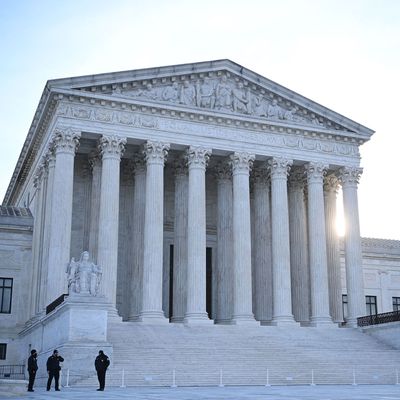
In a “shadow docket” order that will have significant short-term and long-term effects on redistricting and racial-gerrymandering laws, five conservative U.S. Supreme Court justices set aside a lower-court ruling that would have forced Alabama to draw a congressional map for the next decade that better reflects the state’s demographics.
The facts of the case are clear and uncontested: Last year, the Republican-controlled Alabama legislature drew the state’s new congressional map to provide six majority-white (and sure to be Republican) districts and one majority-Black (and sure to be Democratic) district even though 27 percent of Alabama’s population is Black and concentrated in a way that would easily accommodate a second majority-Black district. On January 24, a three-judge federal district court panel (including two judges appointed by Donald Trump) unanimously held that the map violated Section 2 of the Voting Rights Act of 1965 based on existing Supreme Court precedents, and it ordered the legislature to substitute one of the many available maps with two majority-Black districts for its tainted plan.
But now the Supreme Court has granted Alabama’s “emergency” appeal to reimpose its original map. As is generally the case in such “shadow docket” decisions (rulings on time-sensitive petitions when the Court is not in session or when circumstances won’t permit full briefings, oral arguments, and deliberations), the rationale for the action of the majority isn’t clear. Three conservative justices (Clarence Thomas, Neil Gorsuch, and Amy Coney Barrett) silently concurred, while two (Brett Kavanaugh joined by Samuel Alito) filed a concurring opinion heavily emphasizing the so-called Purcell doctrine, which discourages federal-court interventions in such cases too close to elections. The Court’s three liberal justices (Stephen Breyer, Sonia Sotomayor, and Elena Kagan) joined in a dissent written by Kagan arguing that the district-court decision gave the legislature plenty of time to comply before Alabama’s May primary date and accusing the majority of covertly reversing Voting Rights Act precedents to let Alabama (and probably other southern states) get away with racial gerrymandering:
Today’s decision is one more in a disconcertingly long line of cases in which this Court uses its shadow docket to signal or make changes in the law, without anything approaching full briefing and argument. Here, the District Court applied established legal principles to an extensive evidentiary record. Its reasoning was careful — indeed, exhaustive — and justified in every respect. To reverse that decision requires upsetting the way Section 2 plaintiffs have for decades — and in line with our caselaw — proved vote-dilution claims.
But the most striking opinion published by the Court was a separate dissent filed by Chief Justice John Roberts, the author of landmark decisions gutting a key enforcement provision of the Voting Right Act (Shelby County v. Holder in 2013) and restricting federal-court jurisdiction over partisan gerrymandering (Ruccho v. Common Cause and Lamone v. Benisek in 2019). You’d think he might be eager to further erode Voting Rights Act enforcement in redistricting cases, and you might be right. But he concluded that such a new departure in the law would require a full review with oral arguments since “the District Court properly applied existing law in an extensive opinion with no apparent errors for our correction.” Thus, he said, the 2022 elections should proceed under the requirement that the Alabama legislature create a second majority-Black district, a decision that could in theory be reversed for subsequent elections.
Robert’s dissent makes the brazenness of the majority ruling pretty plain notwithstanding Kavanaugh’s rationalization about the lower court’s tardiness (caused, of course, by the Alabama legislature itself). It most obviously cost Black voters in Alabama (and, for that matter, Democrats) a majority-Black House seat in 2022 — and probably for the rest of the decade — and short-circuited what many experts anticipated would be court orders adding majority-Black House seats in Louisiana, South Carolina and possibly even Georgia.
From a longer-term perspective, Roberts’s concurrence shows he is probably ready to join the majority in this case in further restricting grounds for the application of the Voting Rights Act to redistricting decisions once this or a similar case comes back to the Court for full consideration. And as election law expert Rick Hasen notes, the Supreme Court continues to expand the shadow docket by adopting Kavanaugh’s expansive interpretation of the Purcell doctrine “on steroids” to “shut down important election law changes” by lower federal courts. It’s all pretty bad news for voting rights and for federal-court review of elections at a time when clarity and fairness are badly needed.






























